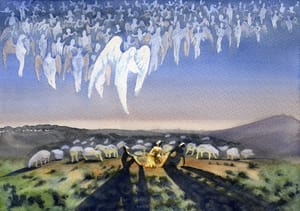We experience the story of Jesus’s birth in a variety of ways throughout the Christmas season. The story is presented through nativity scenes, TV shows, story books, paintings, and Christmas pageants.
In fact, we encounter the Christmas story so often we’re convinced we know all the details of what happened that night. But many of the things we think we ‘know’ about the Christmas story turn out to be incorrect. Here are five common misconceptions.
1. There was a star the night Jesus was born
It’s difficult to find a nativity scene (or Christmas play) without a star over the manger. Indeed, this might be the quintessential symbol of the birth of Jesus. The problem is there’s no indication the star hovered over the manger on the night Jesus was born.
On the contrary, when the angels announced the birth of Jesus to the shepherds watching their flocks by night (Luke 2), they weren’t told to look for a star. They were told to look for something else: ‘And this will be a sign for you: you will find a baby wrapped in swaddling cloths and lying in a manger.’
The star was given not to the shepherds but to the Magi (Matthew 2), who appear to be visiting Jesus at a later time period. How much later is unclear, but the fact that Herod commands all the babies in the region younger than two years old to be killed suggests Jesus may have been in Bethlehem for some time.
2. There were three wise men
Speaking of the wise men, in both art and in song (‘We Three Kings’) we get the undeniable impression there were three of them (also called ‘Magi’). The problem, however, is that this number is found nowhere in the biblical accounts.
Matthew simply tells us, ‘Now after Jesus was born in Bethlehem of Judea in the days of Herod the king, behold, wise men from the east came to Jerusalem’ (Matthew 2:1). The idea of three wise men likely came from the fact that Matthew mentions three gifts: gold, frankincense, and myrrh.















